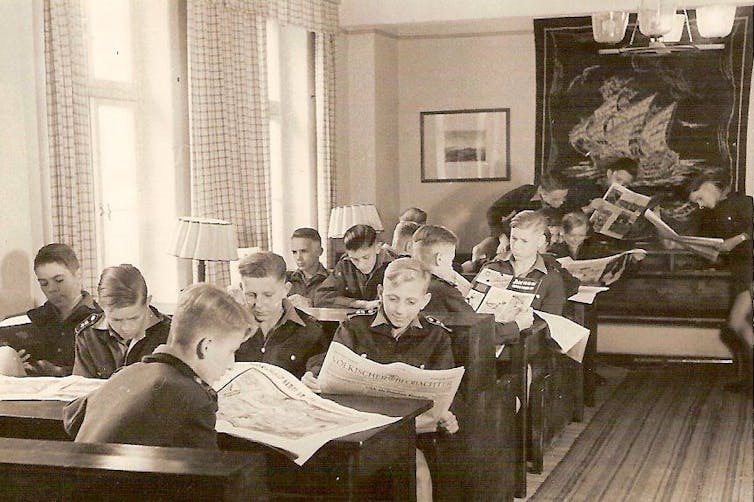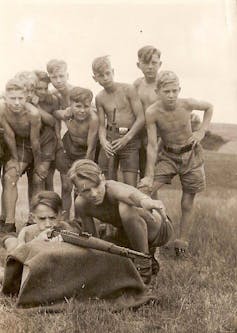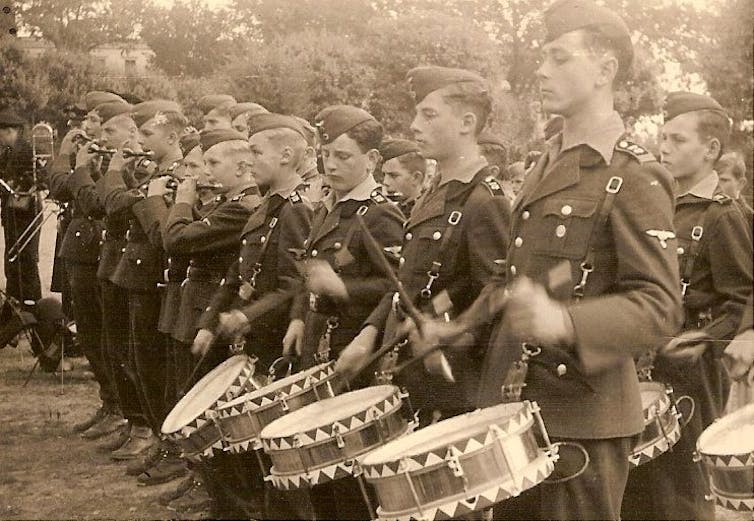In spring 1936, teenage schoolboy – and later war hero – Dick Hargreaves was given the chance to go on an all-expenses-paid exchange trip to Germany. But this was no ordinary school exchange – Hargreaves’ destination was Oranienstein, one of a system of new elite boarding schools known as National Political Education Institutes (“Napolas” for short).
These Nazi colleges were explicitly modelled on an amalgam of the British public schools, the Prussian cadet corps, and the harsh educational practices of ancient Sparta. The schools educated boys from the age of ten upwards, training them as future leaders of the Third Reich. By taking part in the exchange, Hargreaves and his ten companions from Dauntsey’s School in Wiltshire, England, would soon be exposed to the Napolas’ “total” programme of education, indoctrination and National Socialist propaganda.
Hargreaves’ initial impressions, recorded in his diary at the time, are overwhelmingly favourable. The school, situated in the town of Diez an der Lahn, near Koblenz, is described as “a damn good place … a huge castle, done up modern and very posh – armchairs, super labs, stables … school bicycles and heaven [knows] what!” According to the diary, everyone is “extraordinarily decent”, and the boys’ Nazi uniforms are “very smart indeed – light khaki corduroy breeches, black riding boots, khaki coat, red arm band with swastika, brown coat lapels, blue shoulder straps and a dagger thing”.

Dietrich Schulz
Most interesting, though, is Dick’s dispassionate observation of the Nazi Mayday celebrations in the neighbouring town of Diez. On April 30, 1936, his diary records a trip “with our Kameraden” to watch the Maypole being hoisted and folk dances by the Hitler Youth. The boys heard speeches by some of the “big bugs of the town”. There was also community singing in which they all took part.
There was a good bit of ‘Heiling’ which we also did because we were in a huge crowd. It was a magnificent scene – the old castle towering above the market place in which were thousands of enthusiastic peasants lit by torch and candle light…
The following Friday, May 1, which was the spring festival or “Frühlingsfest”, Hargreaves’ diary records that the boys had to get up at six o’clock to salute the flag and parade. They then marched to Diez where they assembled with the local Hitler Youth to listen to a 90-minute speech by Hitler being broadcast on the radio.
The same afternoon, the boys returned to Diez to hear another lengthy speech by “der Führer”. Hargreaves noted:
He worked himself into such a frenzy and was able to move the crowd so tremendously that we saw three people faint. Not from fatigue or crush but just by his amazing oratory powers. Then after Hitler had been ‘Heiled’ off the earth Goering spoke for ½ hour!
Here, the way in which foreign observers could easily be swept up in the fervour of “heiling” and Hitlerism around them is made poignantly clear – although the interminable speeches by Hitler and his henchmen seem to have palled soon enough.
‘Cultural ambassadors’
My decade-long research project on the history of the Napolas – just published as the book The Third Reich’s Elite Schools: A History of the Napolas – has shown that, during the 1930s, hundreds of pupils took part in this programme of exchanges and sporting tournaments.

Dietrich Schulz, Author provided
Just to take one example, between 1935 and 1938, Napola Oranienstein took part in exchanges with British private schools, including Westminster, St Paul’s, Tonbridge School, Dauntsey’s and Bingley School in Yorkshire. The school also entertained headmasters and exchange teachers from Shrewsbury School, Dauntsey’s and Bolton School, and was also involved in sports tournaments with Eton, Harrow, Westminster, Winchester, Shrewsbury, Bradfield and Bryanston.
The Napolas also took part in exchange programmes with several US academies under the aegis of the International Schoolboy Fellowship. American schools involved included Tabor Academy in Massachusetts, St Andrew’s Delaware and Phillips Academy Andover – all considered top-drawer educational establishments.
Ultimately, the Nazi regime wanted the German boys and staff to act as the Third Reich’s “cultural ambassadors”, growing sympathy for Hitler’s policies, and spreading pro-Nazi propaganda. Many British headmasters of the time were persuaded of the wisdom of these exchanges.

Dietrich Schulz, Author provided
E.K. Milliken, the head of Lancing House Prep School in Lowestoft, England, was so enthused by his experiences of the Napola in Naumburg that he even wrote an article expressing his conviction that the exchanges would “further that spirit of true comradeship of which the world so sorely stands in need”, exhorting all members of the Association of Prep Schools to welcome the Napolas with open arms.
Even those who were less easily convinced, such as headmaster A.B. Sackett of Kingswood School in Bath, hoped that the programme could provide “a chance to influence the sons of senior Nazis by discussion and friendship”.
The American reaction seems to have followed a similar pattern, with the headmaster of Tabor Academy, Walter Huston Lillard, still trying to persuade American schools to continue with the programme – even after Kristallnacht, the infamous pogrom in November 1938, during which Jewish-owned homes, business and synagogues were systematically attacked in major towns across Germany.
Overall, both the British and American participants in the Napola exchange programme appear initially to have been ready to give the Nazis the benefit of the doubt. While they may not have been convinced by the Third Reich’s aims and ideals, they continued to hope that their national differences could be cast aside in the name of international cooperation – at least until Nazi belligerence reached its fatal climax.
![]()
Helen Roche does not work for, consult, own shares in or receive funding from any company or organisation that would benefit from this article, and has disclosed no relevant affiliations beyond their academic appointment.











